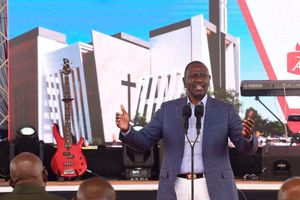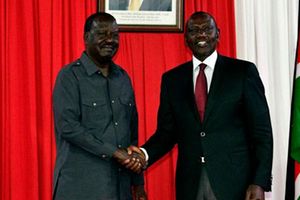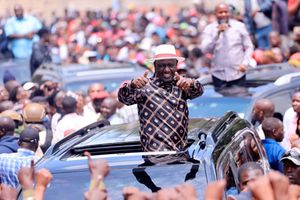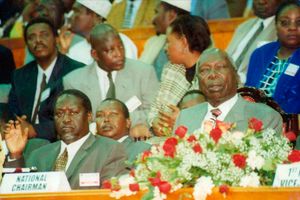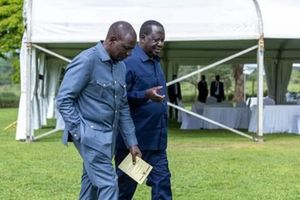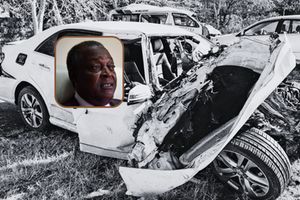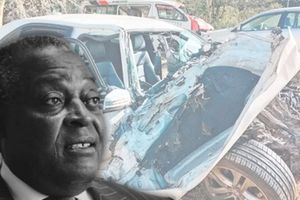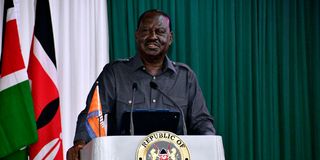
Former Prime Minister Raila Odinga speaks during the Memorandum of Understanding (MoU) signing between United Democratic Alliance and Orange Democratic Movement at the Kenyatta International Conference Center on March 7, 2025.
Former Prime Minister Raila Odinga is unapologetic in the face of fierce criticism following his rapprochement with his erstwhile political rival, President William Ruto. In his view, Kenya was on a dangerous and uncharted path of a military takeover after the June 25 invasion of Parliament, and steady leadership was required to pull the country from the precipice.
Relaxed in his Karen residence, Raila in an exclusive interview with Weekly Review expounded on some of the questions still lingering a week after he and Ruto publicly signed a 10-point Memorandum of Understanding binding their respective parties, ODM and UDA.
Mr Odinga, who now straddles a unique position as both leader of the opposition and effective ‘co-principal without portfolio’ in the Ruto government, in typical fashion does not give a short and concise answer. He prefers to deliver history lessons on this Friday morning interview.
He draws parallels between the Gen Z revolt and the situation in Egypt and other countries in North Africa where popular uprisings 15 years ago toppled presidents with no recognisable leaders left yawning chasms where either Islamic militants or military regimes moved in.
“I was the last international leader to be hosted by Mubarak,” he recalls, having as Prime Minister in 2011 visited Egypt to discuss the Nile Waters treaty. Protests were already happening and he assured me that he had things under control. Two weeks later he had been deposed”.
In the ensuing power vacuum, the Muslim Brotherhood, the only organised grouping, won elections only to again face popular protests that then allowed the military to step in and install Defence Minister Gen Abdel Fattah el-Sisi as interim president. He was supposed to serve for one term and then give way to an elected government. Instead, the general simply changed military fatigues for a suit and tie and assumed civilian leadership. He is still in office.
GenZ protestors
But what do events in Egypt have to do with Kenya? Raila explains that when GenZ protestors breached and vandalised Parliament and then started plotting a march to State House. To him, Ruto calling in the military to reinforce an overwhelmed police force was a dangerous escalation that was leading to a handover of power.
A friend, whom he refuses to name, apparently got wind of such a plan and called asking him to urgently intervene to forestall such an eventuality. "Ruto can be removed through the ballot,” he says, “but once soldiers get out of the barracks, they never go back".
Raila has previously explained that he acted to save Kenya from destruction, but he has never before given such details. The jury remains out, however, on whether Raila acted to save Kenya or to save Ruto from the wrath of the people.
He also dismisses accusations that he sold out the GenZ, explaining that throughout the engagement with Ruto, he tried to incorporate youth leaders, but they would have none of it.
The first task, he says, was to put out the fire. After an initial hardline stance, Ruto softened his position by withdrawing the contentious Finance Bill, announcing a raft of austerity measures and dissolving the Cabinet.
The next step would have been to resolve the cause of the fire, which meant responding to GenZ grievances, plus the previous issues captured under the National Dialogue Committee (NADCO) report, and even going back to the outstanding matters from the abortive Building Bridges Initiative he had co-sponsored with former President Uhuru Kenyatta.
What he offered Ruto was convention of a National Dialogue under the constitutional principle that sovereignty rests directly with the people, or through their delegated representatives.
He proposed a national convention of between 3,000 and 5,000 delegates, which would take into account the county’s demographic make profile and give youth between the ages of 18 and 35 at least 45 per cent of the slots. There would also be regional balance and gender parity, and space for interests groups such as civil society, business community, religious groups, professionals and others.
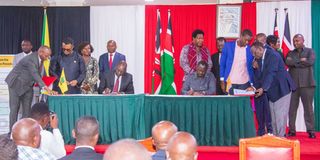
President William Ruto and opposition leader Raila Odinga sign an agreement between UDA and ODM in the presence of their party members.
The ‘leaderless’ GenZ youth, however, rejected all calls for dialogue. “They called it delaying tactics. They wanted immediate resolution of their demands”.
With the country on the brink, Raila says, the stalemate could not hold indefinitely. Ruto then moved to reconstitute his Cabinet, giving some slots to ODM.
What about the other Azimio coalition partners, key ones being 2022 running mate Martha Karua of Narc Kenya (recently rebranded Peoples Liberation Party), Kalonzo Musyoka of Wiper Party, Eugene Wamalwa of DAP-K and the Jubilee party faction loyal to former President Uhuru Kenyatta?
Odinga says they were also invited to join the broad-based government, but rejected all entreaties, denying that he acted behind the backs of his opposition colleagues or otherwise betrayed them.
Things have of course shifted dramatically since then with the impeachment last August of Deputy President Rigathi Gachagua, a move Ruto could not have easily managed without support of Raila’s troops in Parliament.
From a hardline and uncompromising Kenya Kwanza stalwart, Gachagua has done an 180 degree turn to lead a formidable opposition presence in the populous Mt Kenya region, which in 2022 gave Ruto nearly 50 per cent of his presidential election vote. Short of Mt Kenya support, Ruto would almost certainly be heading for the exit door in 2027, hence the need for Raila in his camp.
While Raila denies that there is a deal somewhere for new coalition that will back Ruto’s re-election bid, many of his own MPs are all over the place rooting for the President. And they are also making it clear that their main motivation in backing Ruto is to counter Gachagua, and by extension, the threat of a Mt Kenya comeback.
There is open talk at ODM political rallies of a pact that would unite the rest of the country against Mt Kenya, which is seen to have dominated Kenyan politics, three out of five presidents since independence, and monopolised economic opportunities.
Raila, however, denies that there is anything towards a reprise of the 41 versus 1 strategy believed to have been the ODM game-plan in 2007 that ended in a bloody post-election stalemate. In fact, he insists there was no such strategy, calling it a creation of the media.
But on the openly anti-Mt Kenya rhetoric coming from some of his key allies, Raila counters that if there is anyone promoting ethnic politics, it is Gachagua.
"He is the one who brought that with his murima talk, the You versus Us. He's the one obsessed with ethnic politics. He's the one introducing isolationism", he says, wondering how even as Deputy President, he was promoting murima supremacy and entitlement instead of the national agenda.
Raila prefers not to dwell too much on emerging alliances leading to 2027, but his lieutenants are not as cautious. At a funeral in Kiambu last week of Lewis Waiyaki, a brother of former Foreign Minister Munyua Waiyaki, Raila, as he always does when in the region, ceded some of his time on the podium to one of his key Mt Kenya pointmen, Mweha Kamau, popularly known as Kamau wa Raila.
Kamau did not mince his words, assuring the crowd that despite what people may be saying, Raila will still be in the race come the next elections. “We are just marking time.” He explained in apparent reference to the deal with Ruto, going on to warn that the president if pushed to the wall would hand over power to the military.
“That is Kamau saying that, not me”, Raila explained when he took back the microphone, but the message, which was likely aimed for the Mt kenya audience, had hit home.
Year 2027 aside, a lingering question is on implementation of the 10-point agenda signed with Ruto. It was not a coalition agreement that requires to be deposited with the Registrar of Political Parties, and neither was it a legally binding document. It was more a loose statement of intent, but with clear deliverables or timelines.
One of the key elements is implementation of the NADCO report, but that includes weighty matters such as return of the Office of Prime Minister, which would demand a constitutional amendments ratified through a public referendum.
GenZ uprising
“It’s just a matter of implementation”, Raila explains, but with the rider that issues such as Office of Prime Minister, seen as the key carrot for him, “are not critical, they can wait”.
Other issues, such as a halt to abductions and justice for the victims can be implemented immediately. Matters around high taxation, trigger to the GenZ uprising, can be resolved in Parliament."
But there are perceptions that Ruto, given a lifeline, is walking back on the concessions from the Finance Bill of 2024 and bringing back the same contentious tax proposals in the 2025 version.
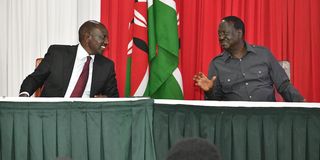
President Willam Ruto and ODM party leader Raila Odinga during the MoU signing event at KICC on March 7, 2025.
There is also the fact that Raila’s ODM occupies a unique position as the largest opposition in Parliament, yet has Cabinet Secretaries in key dockets, including National Treasury, and also chairs some key watchdog committees, including some normally reserved for the Majority Party and some for the Minority.
Can ODM MPs play the oversight role when they view themselves as part of government?
"Parliament as an institution oversights government, not a specific party. As we chair the budget committee nothing stops us from scrutinising proposals brought by the Executive and ensuring fairness in resource allocation. There is no contradiction".
The argument might not be very persuasive given the public conduct of Raila’s MPs. Some of whom are even more strident than Ruto’s UDA brigade in waging war on government critics.
Raila, however, still insists that he only ‘loaned’ Ruto some experts to help save the country from looming disaster, but remains coy on where he will stand should the government fail on its promises and face the wrath of voters in 2027.
He is still interested in a national convention, but is keen to see that whatever can be implemented on his MoU acted on immediately.
As to the widespread speculation of a looming cabinet reshuffle to bring more of his nominees into the Cabinet as well as appointments to senior public service positions, his short answer is “I am not aware”.
He rejects accusations that the pact with Ruto was an elite power-share, pointing out that he has not taken any office, but it is apparent he has become a magnet for individuals and groups lobbying for position.
He is emphatic that his cooperation agreement with President William Ruto is not leading to a formal coalition or a deal to support the incumbent’s 2027 re-election bid, a narrative driven by some of his own Members of Parliament.
"Those are over-enthusiastic MPs enjoying themselves. What they are saying has no relevance to our party position. ODM has never passed a resolution to support Ruto in 2027," he says.

